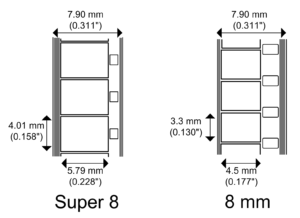The distinction between 8mm and Super 8 film formats has always been a hot topic of discussion in the exciting field of cinematography. It is essential that you comprehend these distinctions whether you work in the production of archives, are involved in filmmaking, or are simply interested in history. This article will explore the differences between 8mm and Super 8 in terms of the technical specifications, historical context, and visual features that distinguish the two formats.
The Industry Gold Standard Is 8mm Film
8mm film, sometimes referred to as Standard 8 or Regular 8, was a groundbreaking format when it was first made available by Kodak in 1932. It made use of 16mm film material that had been horizontally divided, which made it possible to record two different sets of images on each frame. When one side of the film has been exposed, the film is flipped over so that the other side can be shot. The film is cut into two pieces and then joined back together again during the processing step, which results in a single strip that contains images from both sides of the film.
The Super 8: The Enhanced Version
A few years later, in 1965, Kodak released Super 8, a film format that built upon the foundation established by 8mm film. The width of the film stock was kept the same, but smaller perforations were added along the margins of the Super 8 film, which enabled a bigger frame size and resulted in an improvement in image quality. Because each Super 8 cartridge came with its own built-in film leader, the process of loading the cartridge was simplified and made more time-efficient.
Frame Quantity as well as Quality
In comparison to 8mm, Super 8 provides higher image quality as a result of its larger frame size and smaller perforations in the film. As a result of increasing the frame size, more substantial detail and clarity can be captured in the footage. Amateur filmmakers and people who are passionate about home movies will find that Super 8 is an unavoidable option due to the fact that it offers superior color reproduction and higher overall image sharpness.
The Distinctive Characteristics of Sprocket Holes
The size and contour of the sprocket holes is one of the most immediately noticeable distinctions between 8mm and Super 8 film. Super 8 film contains tiny sprocket holes that are virtually square in shape, in contrast to the bigger, more rectangular 8mm film sprocket holes. This distinction has repercussions not just for the visual quality but also for the kind of technology that is required for projection.

A Trip Through Time, Embedded in its Historical Context
The world of amateur filmmaking underwent a fundamental transformation when Super 8 was first made available to consumers. Because of its increased image quality, user-friendly design, and widespread availability of color film stock, it quickly gained popularity among professional and amateur filmmakers alike. As a direct consequence of this, the Super 8 format eventually came to dominate the market for home movies produced during the 1960s and 1970s. Despite this, 8mm film was still used, particularly by individuals who favored the familiarity of the older format or who already possessed the necessary equipment.
Keeping One’s Charm in the Age of Digital Technology
Both 8mm and Super 8 film types are becoming increasingly rare in today’s digital environment. Despite this, there is still a thriving community of filmmakers, archivists, and aficionados that value the unique visual aesthetics and nostalgic allure of these analog formats. In today’s digital world, there are still a significant number of people who shoot and project 8mm and Super 8 films, helping to keep the romance of analog filmmaking alive.
The final word
Although the 8mm and Super 8 film formats both originated from the same place, there are numerous ways in which they are not interchangeable. Some of these ways include the technical specifications, visual characteristics, and historical significance of each format. When embarking on a journey into the realm of analog filmmaking or conserving cherished memories, it is important to be aware of these distinctions so that you may make an educated decision.

